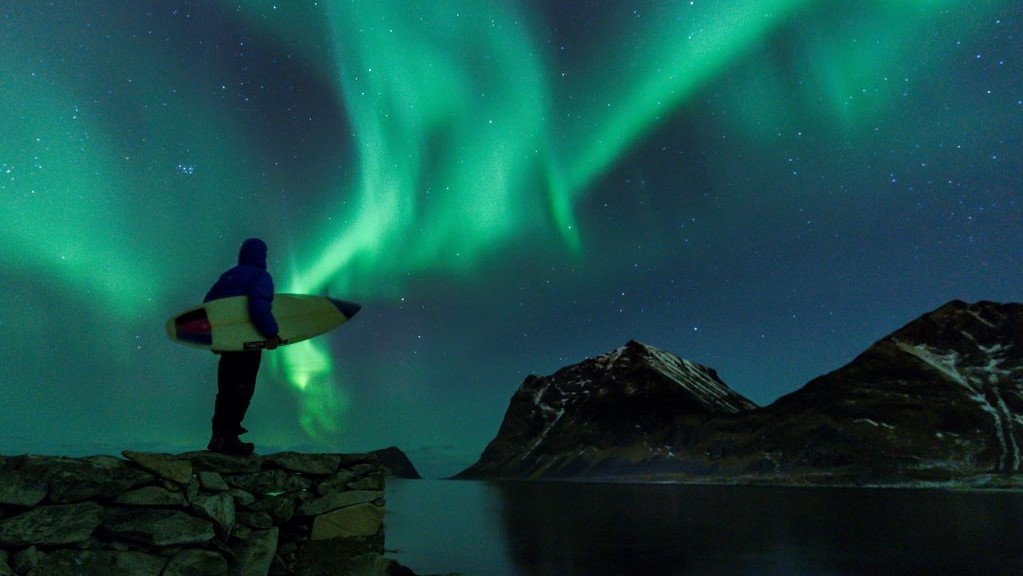Earth's aurora origin mystery solved by 'surfing' electrons
They provide the boost needed for aurora displays

The aurora borealis found in the Northern Hemisphere and aurora australis in the Southern Hemisphere have captivated humankind since the dawn of civilization. These natural light shows provide the closest opportunity we can get to experiencing space weather — conditions that are caused by activity on the sun's surface and as such, they follow the solar cycle.
Auroras are caused when electrons emitted from the sun as part of the 'solar wind' hurtle towards Earth and are funneled down Earth's magnetic field lines where they then collide with oxygen and nitrogen molecules in the ionosphere — the upper atmosphere between 50 and 370 miles (80 and 600 kilometers). The absorption of energy by oxygen and nitrogen ions causes them to move to an 'excited' high-energy state. To relax, the molecules re-radiate the energy as light, which is presented as ribbons of greens and red hues in the sky — the aurora.
Though scientists understand what causes auroras, a mystery remained — just how do these electrons accelerate to speeds of up to 45 million miles per hour on the last stretch of their journey into the ionosphere? A team of physicists led by the University of Iowa now have the answer, their findings were published online on June 7 in the journal Nature Communications.
Related: What is the ionosphere? (And who is Steve?)
Scientists have found the first definitive evidence that the electrons catch a wave — specifically Alfvén waves, that travel Earthward along magnetic field lines above auroras.
Experiments carried out at the Large Plasma Device (LPD) in the University of California, Los Angeles' (UCLA) Basic Plasma Science Facility involved simulating conditions in the Earth's aurora magnetosphere — the region of space where Earth's magnetic field and solar wind interact. The team then launched Alfvén waves down the plasma device's 65 foot (20 meter) long chamber and recorded whether electrons within the chamber were affected by the Alfvén waves.
"Measurements revealed this small population of electrons undergoes 'resonant acceleration' by the Alfvén wave's electric field, similar to a surfer catching a wave and being continually accelerated as the surfer moves along with the wave," said Gregory Howes, an associate professor of physics at the University of Iowa in a statement.
Get the Space.com Newsletter
Breaking space news, the latest updates on rocket launches, skywatching events and more!
Scientists measured the resonant acceleration and found it to be significant enough to accelerate electrons to levels needed to create aurora displays thus providing the first direct evidence that electrons surfing on Alfvén waves create aurora.
This notion of 'surfing' electrons was first theorized by Russian physicist Lev Landau in 1946 and is known as Landau damping. In this new study, scientists have proven his theory through supportive experimental measurements, numerical simulations and mathematical modeling.
Follow us on Twitter @Spacedotcom and on Facebook.
Join our Space Forums to keep talking space on the latest missions, night sky and more! And if you have a news tip, correction or comment, let us know at: community@space.com.

Daisy Dobrijevic joined Space.com in February 2022 having previously worked for our sister publication All About Space magazine as a staff writer. Before joining us, Daisy completed an editorial internship with the BBC Sky at Night Magazine and worked at the National Space Centre in Leicester, U.K., where she enjoyed communicating space science to the public. In 2021, Daisy completed a PhD in plant physiology and also holds a Master's in Environmental Science, she is currently based in Nottingham, U.K. Daisy is passionate about all things space, with a penchant for solar activity and space weather. She has a strong interest in astrotourism and loves nothing more than a good northern lights chase!









